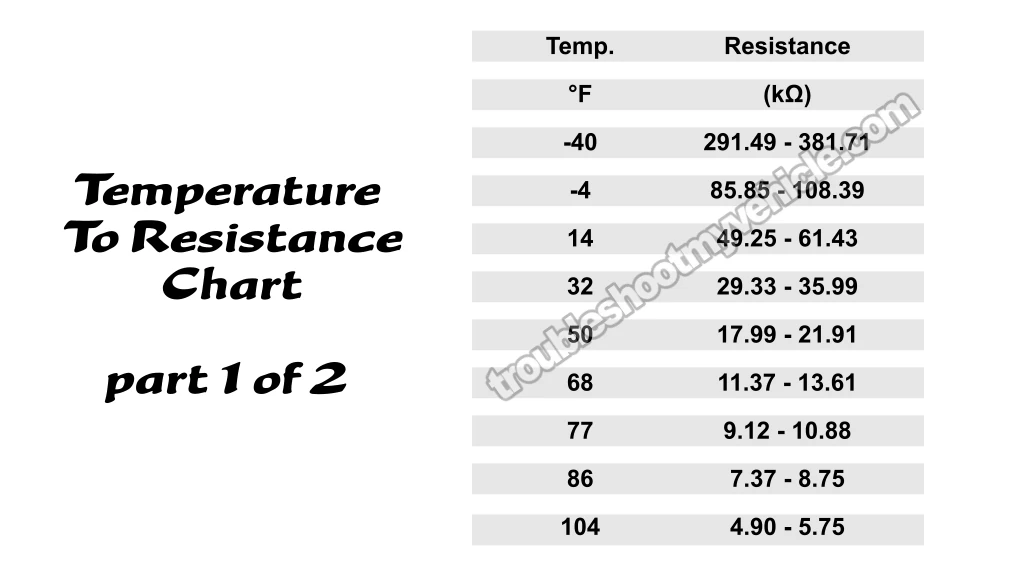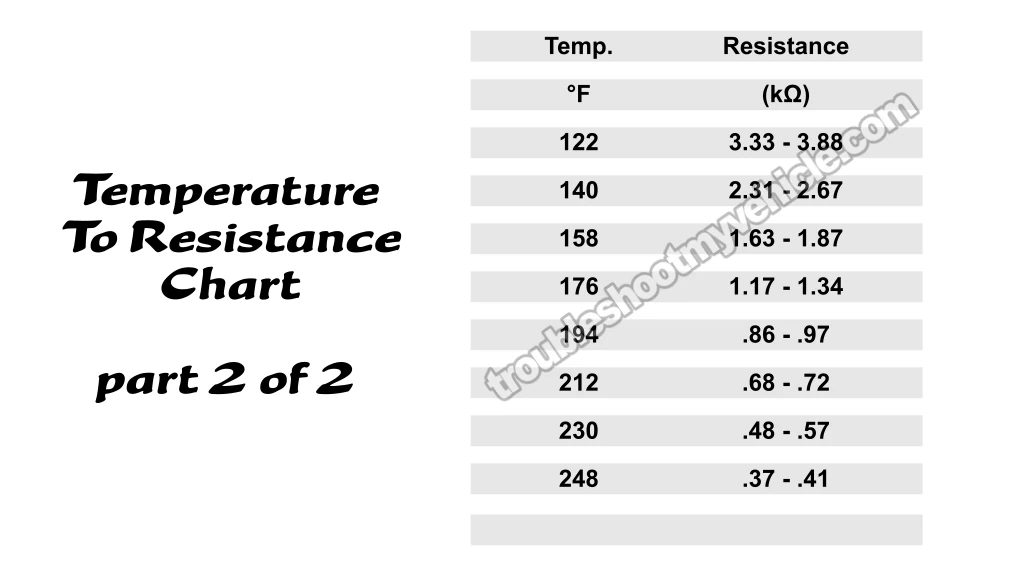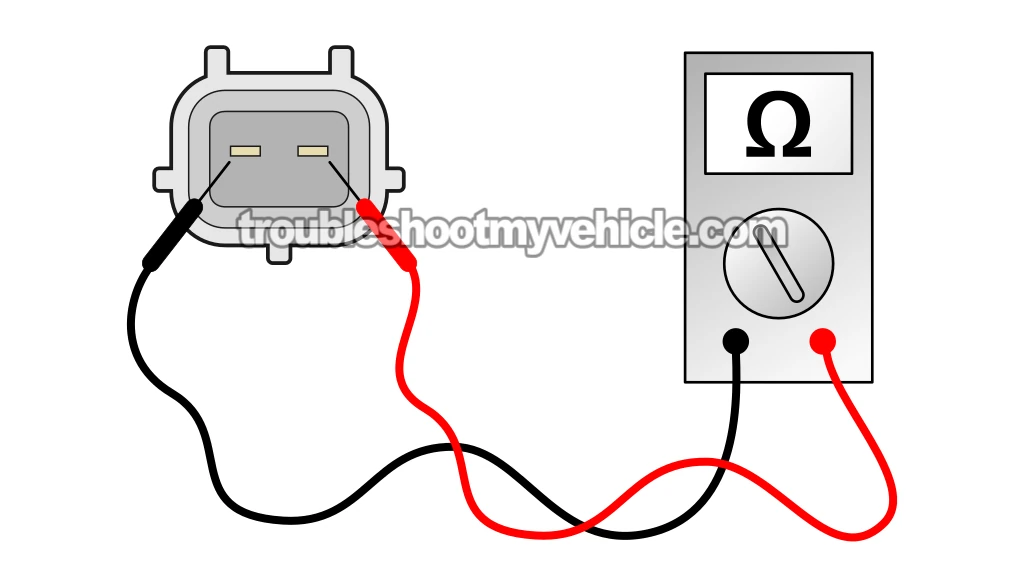
The intake air temp (IAT) sensor tells your V8 Dodge Ram van's computer how hot or cold the air is as it moves through the intake manifold. You're probably gonna be surprised how simple it is to check if it's working right —or if it's shot.
In this tutorial, I'll show you how to test the IAT sensor with a multimeter. You'll be able to quickly tell if it's doing its job or not. I'm also gonna point out a few common issues that trigger IAT sensor codes.
NOTE: The intake air temp (IAT) sensor is also known as the air charge temp (ACT) sensor—they're the same part!
Contents of this tutorial:
- Symptoms Of A Bad Intake Air Temperature (IAT) Sensor.
- What Does The Intake Air Temperature (IAT) Sensor Do?
- Common Intake Air Temperature (IAT) Sensor Problems.
- Initial Checks Before Starting The IAT Sensor Tests.
- Where To Buy The IAT Sensor And Connector.
- Checking Temperature To Resistance Value Relationship.
- More 5.2L, 5.9L Dodge Ram Van Tutorials.
APPLIES TO: This tutorial applies to the following vehicles:
- Dodge Ram 1500 Van 5.2L V8: 1998, 1999, 2000, 2001, 2002, 2003.
- Dodge Ram 2500 Van 5.2L V8: 1998, 1999, 2000, 2001, 2002, 2003.
- Dodge Ram 3500 Van 5.2L V8: 1998, 1999, 2000, 2001, 2002, 2003.
- Dodge Ram 1500 Van 5.9L V8: 1998, 1999, 2000, 2001, 2002, 2003.
- Dodge Ram 2500 Van 5.9L V8: 1998, 1999, 2000, 2001, 2002, 2003.
- Dodge Ram 3500 Van 5.9L V8: 1998, 1999, 2000, 2001, 2002, 2003.
Symptoms Of A Bad Intake Air Temperature (IAT) Sensor
When the IAT sensor goes bad, your PCM stores an IAT trouble code —and yeah, the check engine light's gonna light up too. You'll usually see one of these:
- P0112: Intake Air Temperature (IAT) Sensor Voltage Low.
- P0113: Intake Air Temperature (IAT) Sensor Voltage High.
A faulty IAT sensor doesn't just stop at throwing a trouble code. It's gonna mess with engine performance in several ways:
- Hard starts: If the sensor's not reading the correct intake air temp, especially in extreme weather, your engine's gonna struggle to start.
- Reduced engine power: You'll feel like your engine's lost its punch.
- Rough idle: The engine might shake or feel unstable. You'll especially notice this when the engine is idling with the transmission in Drive.
- Engine stalls: It might suddenly die —either while idling in Drive (like at a red light) or when you're trying to accelerate.
- Engine no-start: Sometimes, it won't start at all —nothing, nada.
- Bad gas mileage: Since the PCM's dumping in too much fuel, your gas mileage is gonna take a hit.
What Does The Intake Air Temperature (IAT) Sensor Do?
The IAT sensor's a thermistor. That just means it's a resistor that changes its resistance based on temperature. It tells the PCM how hot or cold the air is as it enters the engine.
The PCM sends it a 5-volt signal. As the air temp changes, the sensor's resistance shifts, and that changes the voltage.
The computer watches this voltage drop and compares it with its built-in calibration data to figure out the exact air temperature going into the engine.
So where does this fit into your Dodge Ram van's fuel injection system? Simple. Your van uses a speed-density setup, not a MAF-based one. That means it doesn't measure the actual amount of air coming in —it calculates it.
To do that, the PCM needs info from three main sensors. Once it has that, it knows how much fuel to inject.
Here are the three key inputs it uses:
- Engine speed from the crankshaft position (CKP) sensor.
- Vacuum pressure in the intake manifold from the manifold absolute pressure (MAP) sensor.
- Air temp going into the engine from the intake air temperature (IAT) sensor.
Bottom line: The PCM uses the IAT, MAP, and CKP sensor readings to control the air/fuel mixture, adjust timing, and make sure your V8 Dodge Ram van runs like it should.
Common Intake Air Temperature (IAT) Sensor Problems
It's pretty normal for the IAT sensor to wear out at some point. Here are the main reasons why that happens.
- Wear and tear: Like any other part on your vehicle, the IAT sensor ages. After a while, it just stops working the way it should.
- Open circuit faults: Sometimes the sensor develops an internal break in its circuit. When that happens, the PCM sees a super cold air temp continually —around -40°F.
- Short circuits: Other times, the sensor shorts out internally. That makes it send a false high reading —like 248°F or more — to the PCM.
- Wiring damage: The insulation on the wires near the sensor connector can dry out or crack. When that peels off, the bare copper can touch and cause a short.
- Connector issues: Unplugging the sensor —even carefully— can snap the locking tab on the connector. That's super common and can cause a loose or intermittent connection to the PCM.
Any of these conditions will cause the sensor to feed bad info to the PCM. That leads to engine performance problems and IAT-related trouble codes.
Initial Checks Before Starting The IAT Sensor Tests
Before you jump into testing the IAT sensor, knock out these quick checks first:
- Look closely at the sensor wiring. Any cuts, frays, or damage? Repair it and see if that solves the issue.
- Now check the connector. Make sure it's not cracked and the locking tab isn't broken off.
- Take a peek at the sensor itself —especially the plastic top. That part can snap off from the metal base.
Fraying around the connector wires is one of the most common problems. When the insulation breaks down, it exposes the copper wire underneath —and that can lead to IAT sensor trouble fast.
If those bare wires touch, they'll short out. That throws off the air temp reading and turns on the check engine light.
Here's a real-world example of what that kind of damage looks like:
- IAT Sensor Wire Insulation Problem And Wires Shorted Together (via easyautodiagnostics.com).
You've got a couple options for fixing it:
- If the damage is bad or close to the connector, the best move is to replace the whole connector.
- If it's minor and farther from the connector, wrapping the damaged wires with electrical tape might do the trick for now.
NOTE: Don't trust electrical tape for a long-term fix. Whether the damage is light or serious, replacing the connector or wires is the way to go if you want a solid, lasting repair.
Where To Buy The IAT Sensor And Connector
Disclosure: As an Amazon Associate, I earn from qualifying purchases. If my tutorials help you, using these links is an easy way to support the site at no extra cost to you. Thank you!
Checking Temperature To Resistance Value Relationship
Quick reminder: the IAT sensor changes resistance depending on the temp of the air it's exposed to —specifically, the air flowing through the intake manifold.
You can check the IAT sensor's resistance super easily using a multimeter set to Ohms. The number you get should correspond to the air temp around you at the time of the test (see the Temp-To-Resistance Chart above).
A good sensor will show a resistance that lines up with the ambient temperature in the chart —usually within about 10 degrees of whatever it is outside.
If the sensor's bad, your multimeter will show one of these:
- Open circuit: The screen will display "OL", which stands for "over limit" —this means there's a break in the circuit and resistance is infinite.
- Short circuit: If you see "0 Ohms", that means there's a short in the sensor, and confirms it's bad.
IMPORTANT: For the most accurate reading, the sensor's gotta be cold. If your engine's been running, wait until everything completely cools down before testing.
Alright, here's how to test it:
- 1
Check the outside temperature where you are.
Open your phone's weather app or check a thermometer nearby. You need a real-time temp reading to match your multimeter results to the temp in the Temp-To-Resistance Chart. - 2
Find the IAT sensor and unplug it from it's 2-wire connector.
LOCATION: It's mounted near the front of the intake manifold on the passenger side of the engine. (See Photo 4 in the image viewer above for reference.) - 3
OPTIONAL: Carefully remove the sensor from the manifold.
NOTE: You can test it without removing it, but if it's easier to pull it out, go for it. - 4
Set your multimeter to its Ohms (Ω) setting.
- 5
Measure the resistance by touching the multimeter probes to the sensor's two male pins.
- 6
Write down the number you see on the multimeter's display.
- 7
Compare your reading to the Temperature-To-Resistance Chart (you'll find it in the image viewer above).
The resistance should be close to the expected value for your local air temp (within ±10°F).
Now let's break down what your results mean:
CASE 1: The resistance doesn't match what it should be for your outside temp. That means the IAT sensor is malfunctioning. Replace it with a new one.
CASE 2: The resistance matches the expected range for your current temp. That means the IAT sensor is doing its job. No need to change it.
More 5.2L, 5.9L Dodge Ram Van Tutorials
You can find a complete list of tutorials for the 5.2L/5.9L V8 Dodge Ram Van in this index:
Here's a sample of the tutorials you'll find in the index:
- How To Test The MAP Sensor (1998-2003 5.2L, 5.9L V8 Dodge Ram Van).
- Testing The Front Oxygen Sensors (1996-2003 5.2L, 5.9L V8 Dodge Ram Van).
- How To Test The TPS (1997-2003 5.2L, 5.9L V8 Dodge Ram Van).
- How To Test For A Blown Head Gasket (1989-2003 5.2L, 5.9L V8 Dodge Ram Van).

If this info saved the day, buy me a beer!








